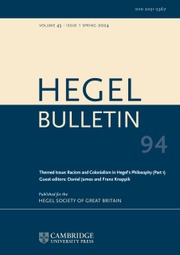Article contents
Must it Be Abstract? Hegel, Pippin, and Clark
Published online by Cambridge University Press: 23 June 2015
Abstract
By comparison with other parts of his philosophy, Hegel's Aesthetics has been slighted by Anglo-American philosophers. All the more welcome then are two recent essays by Robert Pippin, which promise to go well beyond received notions. With Hegel's Idealism, Pippin published what is by any measure one of the most original of recent treatments. Shortly thereafter came a penetrating study of the idea of the modern, which allotted a central role to artistic modernism, and since then he has published various essays actively engaging our post-Kantian legacy. Readers will therefore have heightened expectations of Pippin's turn to Hegel's aesthetics, or rather, as he himself signals, the philosophy of art — unlike some he clearly approves of the shift from Kantian questions of aesthetic taste to Romantic speculations on art, indeed on Art as cultural absolute.
They will hardly be disappointed. Yet in the event they will find themselves negotiating texts that are at once dense and elliptical, much of the argument being conducted via footnotes, its implications—what it commits the author to in theory and in practice — not evident straightaway. If Hegel's position (so far as one can speak of such a thing, when it is known largely from student notes made over a number of years) is complex, Pippin's turns out to be no less so. While I can hardly do justice to its intricacies, I do consider it both important and controversial, whether as interpretation of Hegel or as an approach to modernist abstraction.
- Type
- Articles
- Information
- Bulletin of the Hegel Society of Great Britain , Volume 28 , Issue 1-2: number 55/56 , 2007 , pp. 87 - 106
- Copyright
- Copyright © The Hegel Society of Great Britain 2007
References
- 1
- Cited by




